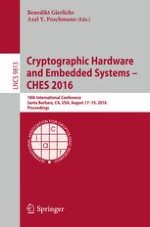2016 | Buch
Cryptographic Hardware and Embedded Systems – CHES 2016
18th International Conference, Santa Barbara, CA, USA, August 17-19, 2016, Proceedings
herausgegeben von: Benedikt Gierlichs, Axel Y. Poschmann
Verlag: Springer Berlin Heidelberg
Buchreihe : Lecture Notes in Computer Science

